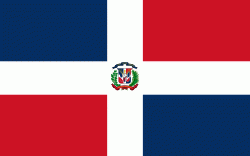Los Cacaos (Los Cacaos)
Los Cacaos is a municipality (municipio) of the San Cristóbal province in the Dominican Republic.
As of the 2012 census the municipality had 49,858 inhabitants. For comparison with other municipalities and municipal districts see the list of municipalities and municipal districts of the Dominican Republic.
As of the 2012 census the municipality had 49,858 inhabitants. For comparison with other municipalities and municipal districts see the list of municipalities and municipal districts of the Dominican Republic.
Map - Los Cacaos (Los Cacaos)
Map
Country - Dominican_Republic
 |
 |
| Flag of the Dominican Republic | |
The native Taíno people had inhabited Hispaniola before the arrival of Europeans, dividing it into five chiefdoms. They had constructed an advanced farming and hunting society, and were in the process of becoming an organized civilization. The Taínos also inhabited Cuba, Jamaica, Puerto Rico, and the Bahamas. The Genoese mariner Christopher Columbus explored and claimed the island for Castile, landing there on his first voyage in 1492. The colony of Santo Domingo became the site of the first permanent European settlement in the Americas and the first seat of Spanish colonial rule in the New World. It would also become the site to introduce importations of enslaved Africans to the Americas. In 1697, Spain recognized French dominion over the western third of the island, which became the independent state of Haiti in 1804.
Currency / Language
| ISO | Currency | Symbol | Significant figures |
|---|---|---|---|
| DOP | Dominican peso | $ | 2 |
| ISO | Language |
|---|---|
| ES | Spanish language |















